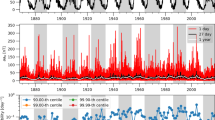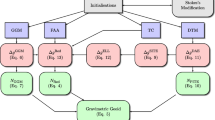Abstract
Out of the necessity to provide quick access to ionospheric model data from various computer programs written in different languages (PASCAL, FORTRAN, IDL, etc.) we developed a “data box” approach in the following way: grid point values are calculated from an existing global or regional model and written into a data file. Good values for grid point distances are 5 degrees in latitude, 10 degrees in longitude and 10 km in height. Third order interpolation is used in all grid variables to find the model value where needed. For ray tracing applications splines can be used over the region of interest instead of simple interpolation.
Two dimensional “data boxes” can enhance computing speed in “classical” models if used for coordinate transforms, e.g., to calculate MODIP and dip latitude within the International Reference Ionosphere (IRI).
By adding a topside F-layer to the existing DGR model which is based on the CCIR parameters we constructed a multi-purpose global model which is continuous in the first derivative of electron density. The topside of this NeUoG model is based on the following 3 parameters, modelled according to the experiences of John Titheridge: O+ scale height at the F-layer peak, its height gradient, and 0+ — H+ transition height (compare Leitinger et al. 1995, 1996, Titheridge 1976a,b, 1993). John Titheridge has used a semi-theoretical approach to find the parameter values from his interpretation of topside sounder data. The second version of NeUoG uses a magnetic field aligned approach for the plasmasphere. We describe our method of field aligned modelling and the plasmasphere part of NeUoG-plas in some detail. We present graphics on the behaviour of the plasmasphere part.
Similar content being viewed by others
References
Leitinger R, Titheridge J E, Kirchengast G, Rothleitner W 1995: A “simple” global empirical model for the F layer of the ionosphere. Wiss. Bericht 1/1995, IMG Uni Graz
Leitinger R, Titheridge J E, Kirchengast G, Rothleitner W 1996: Kleinheubacher Ber. 39, 697–704.
Radicella S M, Zhang M-L 1995: The improved DGR analytical model of electron density height profile and total electron content in the ionosphere. Annali di Geofisica, 38, 35–41, 1995
Rawer K 1990: Adv. Space Res., 10, (11)75–(11)78.
Titheridge J E 1976a: Planet. Space Sci., 24, 229–245.
Titheridge J E 1976b: Planet. Space Sci., 24, 247–259.
Titheridge J E 1993: Atmospheric winds calculated from diurnal changes in the mid-latitude ionosphere. J. atmos. terr. Phys., 55, 1637–1659.
Author information
Authors and Affiliations
Corresponding author
Rights and permissions
About this article
Cite this article
Leitinger, R., Kirchengast, G. Easy to use Global and Regional Ionospheric Models — A Report on Approaches Used in Graz. Acta Geod. Geoph. Hung 32, 329–342 (1997). https://doi.org/10.1007/BF03325504
Published:
Issue Date:
DOI: https://doi.org/10.1007/BF03325504




